Optimal Portfolio Management for Risk-Averse and High Risk Tolerance Investors
VerifiedAdded on 2023/06/11
|11
|3323
|463
AI Summary
This content explains the concept of portfolio management and how to prepare an optimal portfolio to manage the risk and return of investment. It discusses the portfolio overview, risk-averse and high risk tolerance investors, methods to manage and prepare a portfolio, and the optimal portfolio and performance of the portfolio. It also highlights the positive relationship between risk and return of a portfolio and the importance of understanding portfolio management.
Contribute Materials
Your contribution can guide someone’s learning journey. Share your
documents today.
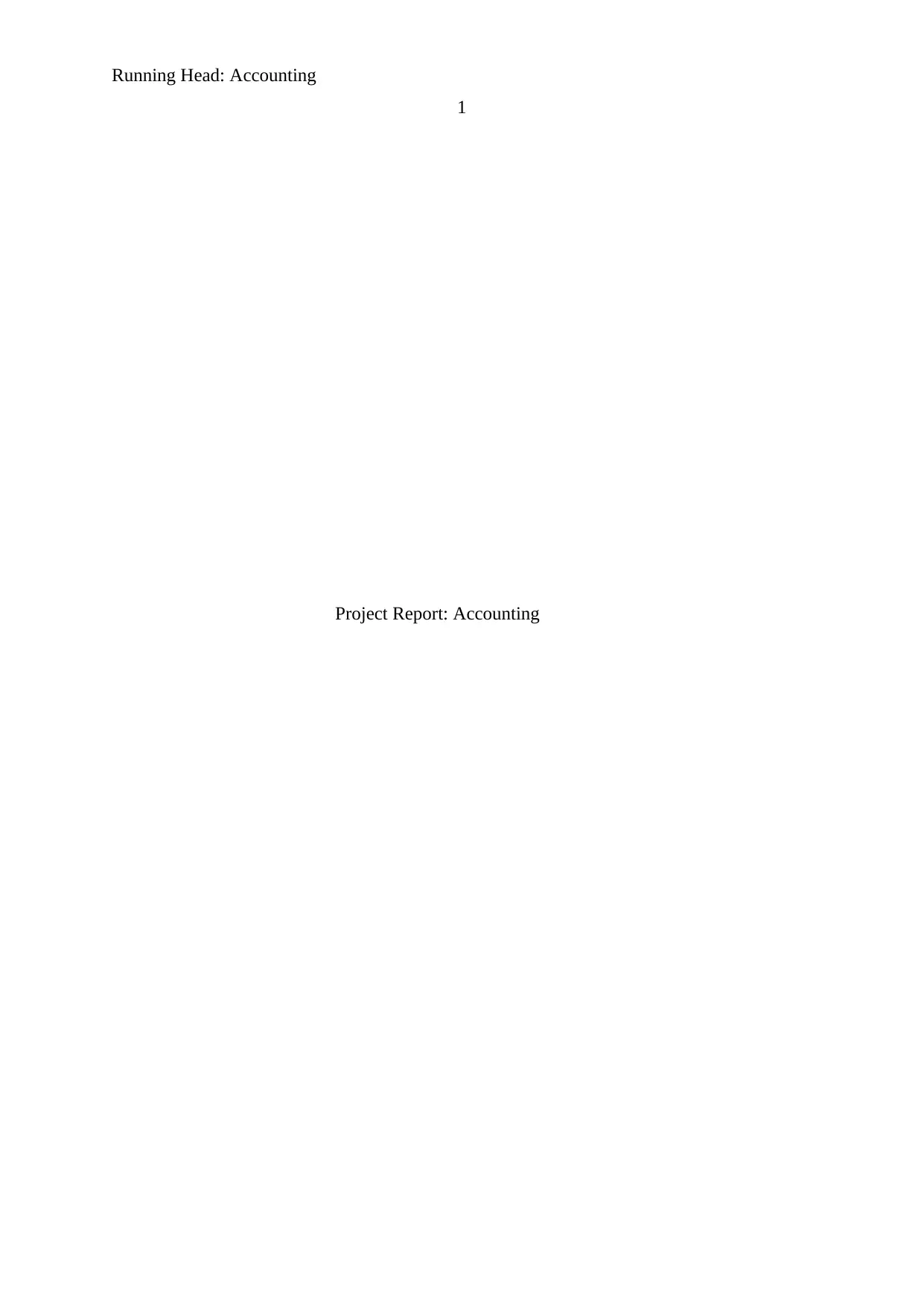
Running Head: Accounting
1
Project Report: Accounting
1
Project Report: Accounting
Secure Best Marks with AI Grader
Need help grading? Try our AI Grader for instant feedback on your assignments.
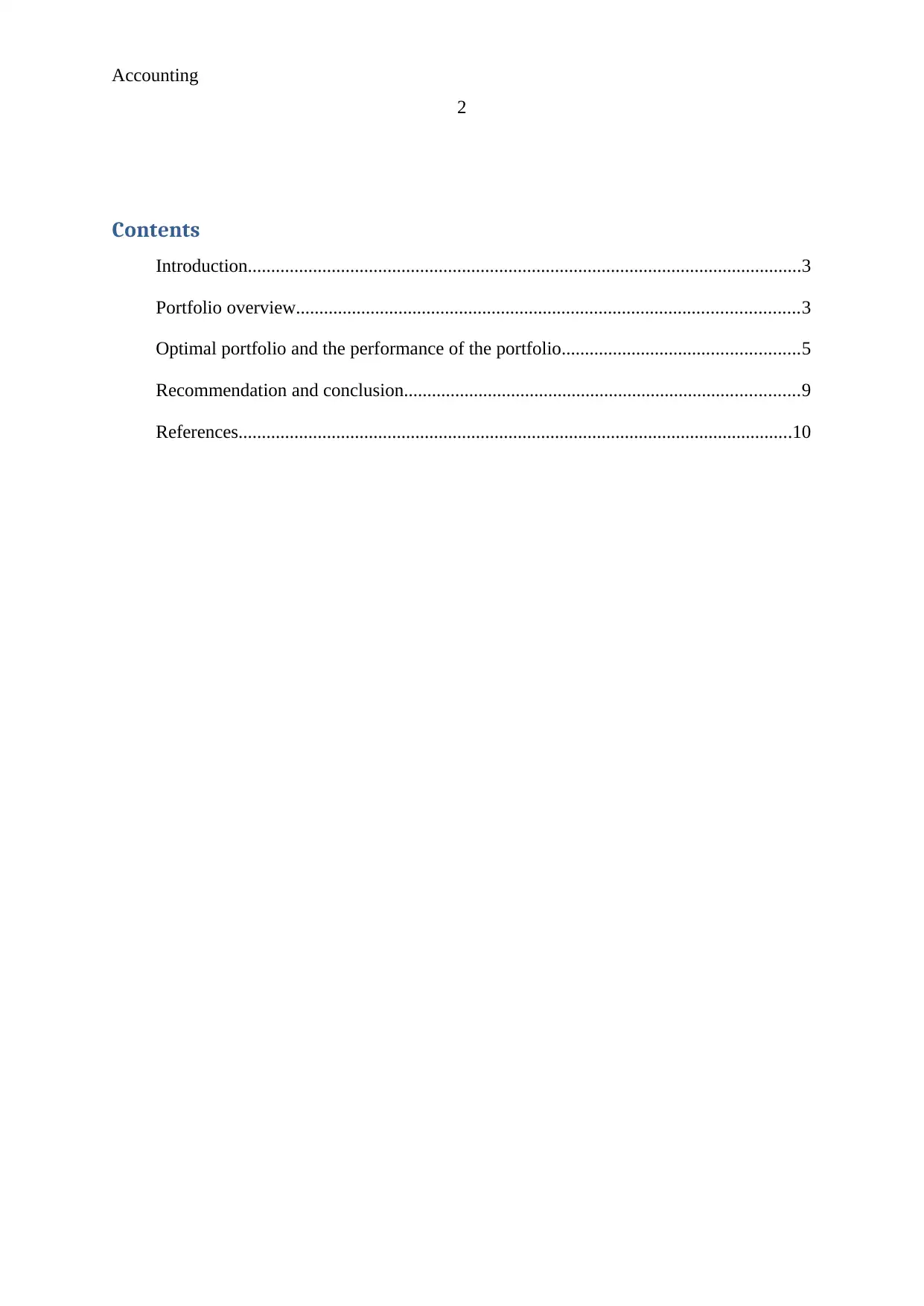
Accounting
2
Contents
Introduction.......................................................................................................................3
Portfolio overview............................................................................................................3
Optimal portfolio and the performance of the portfolio...................................................5
Recommendation and conclusion.....................................................................................9
References.......................................................................................................................10
2
Contents
Introduction.......................................................................................................................3
Portfolio overview............................................................................................................3
Optimal portfolio and the performance of the portfolio...................................................5
Recommendation and conclusion.....................................................................................9
References.......................................................................................................................10

Accounting
3
Introduction:
Portfolio management is an art and science which is used to make decision about the
investment into few securities to manage the risk and return. This portfolio management
process is used to match the investment objective, asset allocation etc for institutions and
individuals and maintain the risk against performance. The overall aim of the portfolio
management is to determine strength, opportunities, threats and weakness of the debts,
equity, domestic shares, international shares, safety, growth etc to attempt to minimize the
risk and maximize the return (Zimmerman and Yahya-Zadeh, 2011).
In the report, the optimal portfolios have been prepared on the basis of the risk and
return. On the basis of the given data, 2 portfolios have been prepared. One portfolio focuses
on the risk-averse investors and other focuses on the high risk tolerance. In the given report,
the performance of both the portfolios has been measured to identify the position of the firms
and the overall returns from the portfolios. For evaluating the risk position and the return of
the assets, equity and debt, FTSE 250 index price has been taken into the concern.
Portfolio overview:
Portfolio is a collection of investment which is all owned by the same investor,
individual or an organization. Normally, these portfolios include stocks, bonds, investment in
individual businesses, government securities, mutual funds, debt etc to reduce the risk level
and manage the return from the overall investment of the individual (William et al, 2015). A
portfolio is prepared in such a way that if one stock is offering the negative result than other
stock, bond or other securities overcome that risk and loss of the individual.
The portfolio explains that all the amount must be invested into different securities so
that the risk could be diversified and a portfolio manger must assures that the investment is
done in the different venture. In the given case, the 3 different firms of UK market have been
taken for the purpose of portfolio. The risk and return of all the firms have been calculated
firstly to make an optimal capital structure for the risk-averse investors and other focuses on
the high risk tolerance.
The risk-averse investors are those individuals or the organization that prefer to take
lower return for the portfolio with known risk rather than taking the higher return from the
unknown risk. These kinds of investors play safe in the security market and invest in those
3
Introduction:
Portfolio management is an art and science which is used to make decision about the
investment into few securities to manage the risk and return. This portfolio management
process is used to match the investment objective, asset allocation etc for institutions and
individuals and maintain the risk against performance. The overall aim of the portfolio
management is to determine strength, opportunities, threats and weakness of the debts,
equity, domestic shares, international shares, safety, growth etc to attempt to minimize the
risk and maximize the return (Zimmerman and Yahya-Zadeh, 2011).
In the report, the optimal portfolios have been prepared on the basis of the risk and
return. On the basis of the given data, 2 portfolios have been prepared. One portfolio focuses
on the risk-averse investors and other focuses on the high risk tolerance. In the given report,
the performance of both the portfolios has been measured to identify the position of the firms
and the overall returns from the portfolios. For evaluating the risk position and the return of
the assets, equity and debt, FTSE 250 index price has been taken into the concern.
Portfolio overview:
Portfolio is a collection of investment which is all owned by the same investor,
individual or an organization. Normally, these portfolios include stocks, bonds, investment in
individual businesses, government securities, mutual funds, debt etc to reduce the risk level
and manage the return from the overall investment of the individual (William et al, 2015). A
portfolio is prepared in such a way that if one stock is offering the negative result than other
stock, bond or other securities overcome that risk and loss of the individual.
The portfolio explains that all the amount must be invested into different securities so
that the risk could be diversified and a portfolio manger must assures that the investment is
done in the different venture. In the given case, the 3 different firms of UK market have been
taken for the purpose of portfolio. The risk and return of all the firms have been calculated
firstly to make an optimal capital structure for the risk-averse investors and other focuses on
the high risk tolerance.
The risk-averse investors are those individuals or the organization that prefer to take
lower return for the portfolio with known risk rather than taking the higher return from the
unknown risk. These kinds of investors play safe in the security market and invest in those
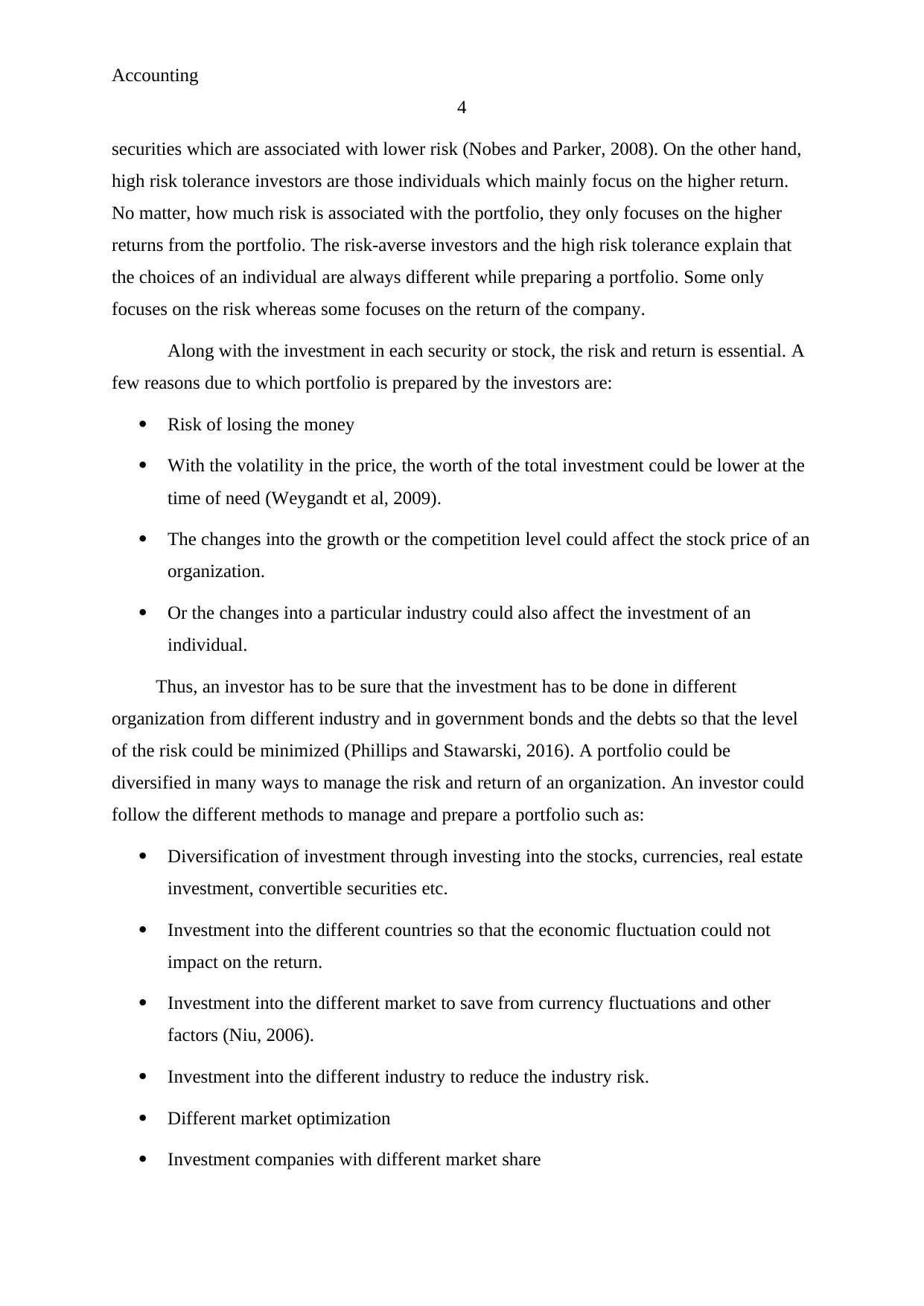
Accounting
4
securities which are associated with lower risk (Nobes and Parker, 2008). On the other hand,
high risk tolerance investors are those individuals which mainly focus on the higher return.
No matter, how much risk is associated with the portfolio, they only focuses on the higher
returns from the portfolio. The risk-averse investors and the high risk tolerance explain that
the choices of an individual are always different while preparing a portfolio. Some only
focuses on the risk whereas some focuses on the return of the company.
Along with the investment in each security or stock, the risk and return is essential. A
few reasons due to which portfolio is prepared by the investors are:
Risk of losing the money
With the volatility in the price, the worth of the total investment could be lower at the
time of need (Weygandt et al, 2009).
The changes into the growth or the competition level could affect the stock price of an
organization.
Or the changes into a particular industry could also affect the investment of an
individual.
Thus, an investor has to be sure that the investment has to be done in different
organization from different industry and in government bonds and the debts so that the level
of the risk could be minimized (Phillips and Stawarski, 2016). A portfolio could be
diversified in many ways to manage the risk and return of an organization. An investor could
follow the different methods to manage and prepare a portfolio such as:
Diversification of investment through investing into the stocks, currencies, real estate
investment, convertible securities etc.
Investment into the different countries so that the economic fluctuation could not
impact on the return.
Investment into the different market to save from currency fluctuations and other
factors (Niu, 2006).
Investment into the different industry to reduce the industry risk.
Different market optimization
Investment companies with different market share
4
securities which are associated with lower risk (Nobes and Parker, 2008). On the other hand,
high risk tolerance investors are those individuals which mainly focus on the higher return.
No matter, how much risk is associated with the portfolio, they only focuses on the higher
returns from the portfolio. The risk-averse investors and the high risk tolerance explain that
the choices of an individual are always different while preparing a portfolio. Some only
focuses on the risk whereas some focuses on the return of the company.
Along with the investment in each security or stock, the risk and return is essential. A
few reasons due to which portfolio is prepared by the investors are:
Risk of losing the money
With the volatility in the price, the worth of the total investment could be lower at the
time of need (Weygandt et al, 2009).
The changes into the growth or the competition level could affect the stock price of an
organization.
Or the changes into a particular industry could also affect the investment of an
individual.
Thus, an investor has to be sure that the investment has to be done in different
organization from different industry and in government bonds and the debts so that the level
of the risk could be minimized (Phillips and Stawarski, 2016). A portfolio could be
diversified in many ways to manage the risk and return of an organization. An investor could
follow the different methods to manage and prepare a portfolio such as:
Diversification of investment through investing into the stocks, currencies, real estate
investment, convertible securities etc.
Investment into the different countries so that the economic fluctuation could not
impact on the return.
Investment into the different market to save from currency fluctuations and other
factors (Niu, 2006).
Investment into the different industry to reduce the industry risk.
Different market optimization
Investment companies with different market share
Secure Best Marks with AI Grader
Need help grading? Try our AI Grader for instant feedback on your assignments.
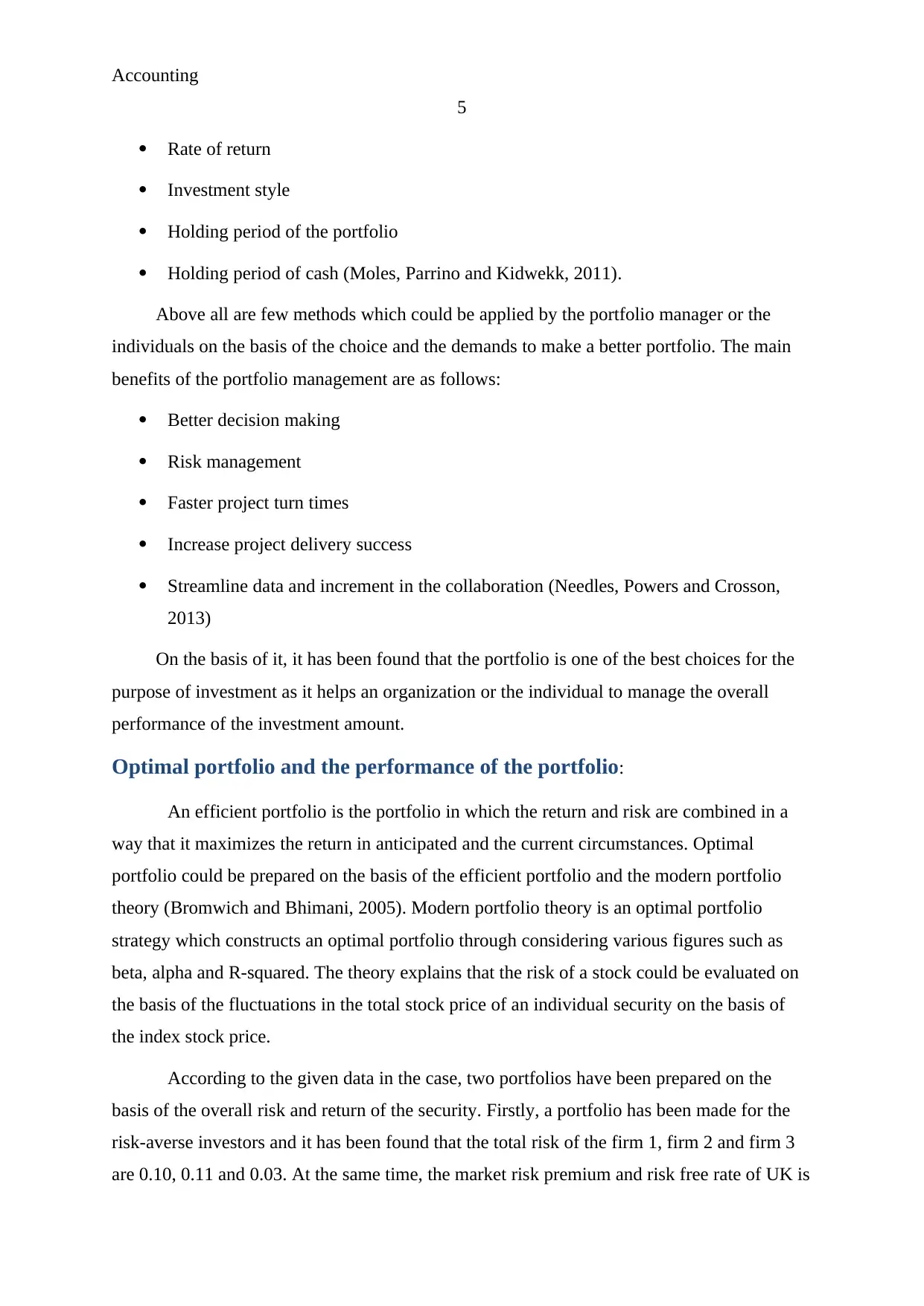
Accounting
5
Rate of return
Investment style
Holding period of the portfolio
Holding period of cash (Moles, Parrino and Kidwekk, 2011).
Above all are few methods which could be applied by the portfolio manager or the
individuals on the basis of the choice and the demands to make a better portfolio. The main
benefits of the portfolio management are as follows:
Better decision making
Risk management
Faster project turn times
Increase project delivery success
Streamline data and increment in the collaboration (Needles, Powers and Crosson,
2013)
On the basis of it, it has been found that the portfolio is one of the best choices for the
purpose of investment as it helps an organization or the individual to manage the overall
performance of the investment amount.
Optimal portfolio and the performance of the portfolio:
An efficient portfolio is the portfolio in which the return and risk are combined in a
way that it maximizes the return in anticipated and the current circumstances. Optimal
portfolio could be prepared on the basis of the efficient portfolio and the modern portfolio
theory (Bromwich and Bhimani, 2005). Modern portfolio theory is an optimal portfolio
strategy which constructs an optimal portfolio through considering various figures such as
beta, alpha and R-squared. The theory explains that the risk of a stock could be evaluated on
the basis of the fluctuations in the total stock price of an individual security on the basis of
the index stock price.
According to the given data in the case, two portfolios have been prepared on the
basis of the overall risk and return of the security. Firstly, a portfolio has been made for the
risk-averse investors and it has been found that the total risk of the firm 1, firm 2 and firm 3
are 0.10, 0.11 and 0.03. At the same time, the market risk premium and risk free rate of UK is
5
Rate of return
Investment style
Holding period of the portfolio
Holding period of cash (Moles, Parrino and Kidwekk, 2011).
Above all are few methods which could be applied by the portfolio manager or the
individuals on the basis of the choice and the demands to make a better portfolio. The main
benefits of the portfolio management are as follows:
Better decision making
Risk management
Faster project turn times
Increase project delivery success
Streamline data and increment in the collaboration (Needles, Powers and Crosson,
2013)
On the basis of it, it has been found that the portfolio is one of the best choices for the
purpose of investment as it helps an organization or the individual to manage the overall
performance of the investment amount.
Optimal portfolio and the performance of the portfolio:
An efficient portfolio is the portfolio in which the return and risk are combined in a
way that it maximizes the return in anticipated and the current circumstances. Optimal
portfolio could be prepared on the basis of the efficient portfolio and the modern portfolio
theory (Bromwich and Bhimani, 2005). Modern portfolio theory is an optimal portfolio
strategy which constructs an optimal portfolio through considering various figures such as
beta, alpha and R-squared. The theory explains that the risk of a stock could be evaluated on
the basis of the fluctuations in the total stock price of an individual security on the basis of
the index stock price.
According to the given data in the case, two portfolios have been prepared on the
basis of the overall risk and return of the security. Firstly, a portfolio has been made for the
risk-averse investors and it has been found that the total risk of the firm 1, firm 2 and firm 3
are 0.10, 0.11 and 0.03. At the same time, the market risk premium and risk free rate of UK is
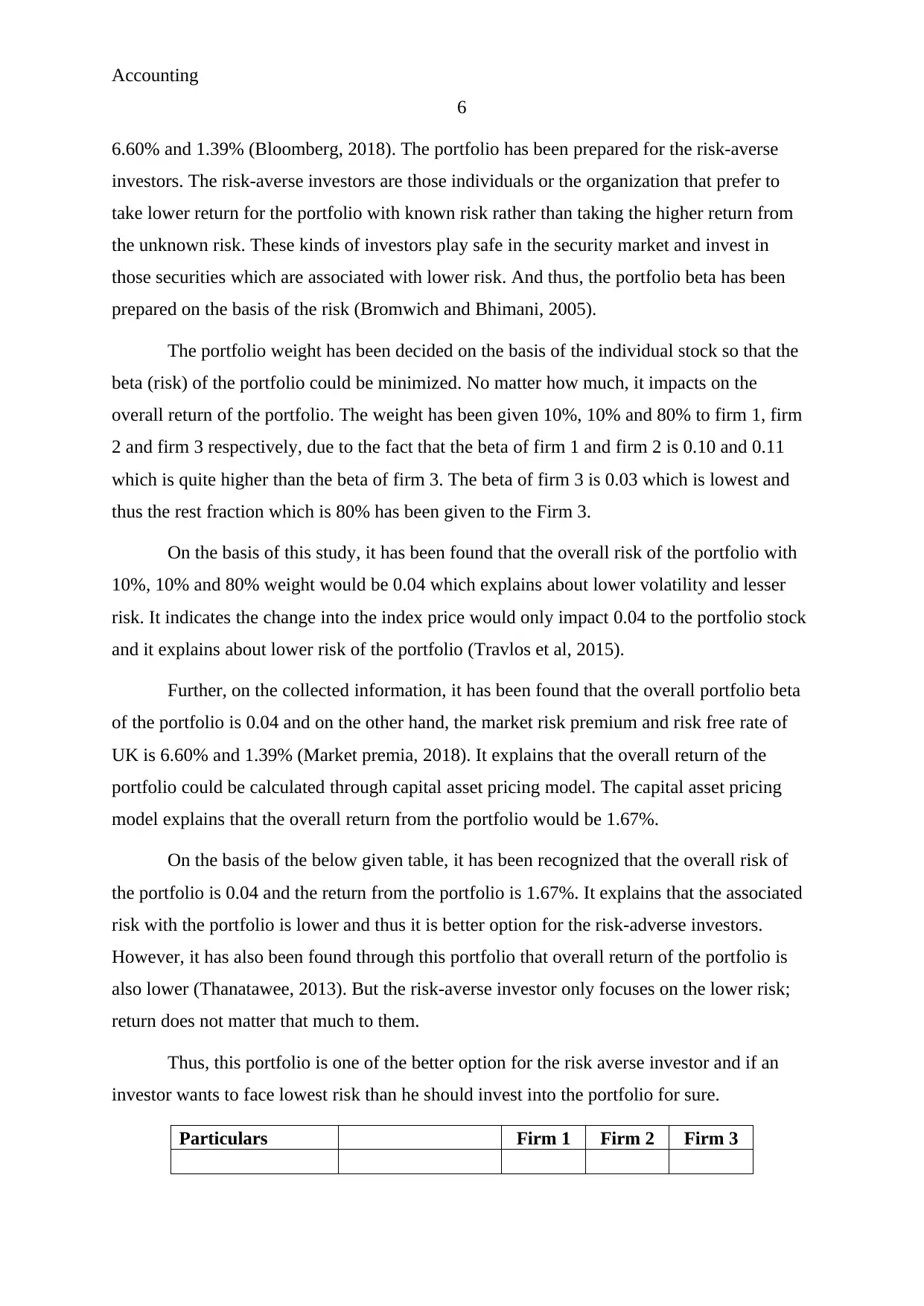
Accounting
6
6.60% and 1.39% (Bloomberg, 2018). The portfolio has been prepared for the risk-averse
investors. The risk-averse investors are those individuals or the organization that prefer to
take lower return for the portfolio with known risk rather than taking the higher return from
the unknown risk. These kinds of investors play safe in the security market and invest in
those securities which are associated with lower risk. And thus, the portfolio beta has been
prepared on the basis of the risk (Bromwich and Bhimani, 2005).
The portfolio weight has been decided on the basis of the individual stock so that the
beta (risk) of the portfolio could be minimized. No matter how much, it impacts on the
overall return of the portfolio. The weight has been given 10%, 10% and 80% to firm 1, firm
2 and firm 3 respectively, due to the fact that the beta of firm 1 and firm 2 is 0.10 and 0.11
which is quite higher than the beta of firm 3. The beta of firm 3 is 0.03 which is lowest and
thus the rest fraction which is 80% has been given to the Firm 3.
On the basis of this study, it has been found that the overall risk of the portfolio with
10%, 10% and 80% weight would be 0.04 which explains about lower volatility and lesser
risk. It indicates the change into the index price would only impact 0.04 to the portfolio stock
and it explains about lower risk of the portfolio (Travlos et al, 2015).
Further, on the collected information, it has been found that the overall portfolio beta
of the portfolio is 0.04 and on the other hand, the market risk premium and risk free rate of
UK is 6.60% and 1.39% (Market premia, 2018). It explains that the overall return of the
portfolio could be calculated through capital asset pricing model. The capital asset pricing
model explains that the overall return from the portfolio would be 1.67%.
On the basis of the below given table, it has been recognized that the overall risk of
the portfolio is 0.04 and the return from the portfolio is 1.67%. It explains that the associated
risk with the portfolio is lower and thus it is better option for the risk-adverse investors.
However, it has also been found through this portfolio that overall return of the portfolio is
also lower (Thanatawee, 2013). But the risk-averse investor only focuses on the lower risk;
return does not matter that much to them.
Thus, this portfolio is one of the better option for the risk averse investor and if an
investor wants to face lowest risk than he should invest into the portfolio for sure.
Particulars Firm 1 Firm 2 Firm 3
6
6.60% and 1.39% (Bloomberg, 2018). The portfolio has been prepared for the risk-averse
investors. The risk-averse investors are those individuals or the organization that prefer to
take lower return for the portfolio with known risk rather than taking the higher return from
the unknown risk. These kinds of investors play safe in the security market and invest in
those securities which are associated with lower risk. And thus, the portfolio beta has been
prepared on the basis of the risk (Bromwich and Bhimani, 2005).
The portfolio weight has been decided on the basis of the individual stock so that the
beta (risk) of the portfolio could be minimized. No matter how much, it impacts on the
overall return of the portfolio. The weight has been given 10%, 10% and 80% to firm 1, firm
2 and firm 3 respectively, due to the fact that the beta of firm 1 and firm 2 is 0.10 and 0.11
which is quite higher than the beta of firm 3. The beta of firm 3 is 0.03 which is lowest and
thus the rest fraction which is 80% has been given to the Firm 3.
On the basis of this study, it has been found that the overall risk of the portfolio with
10%, 10% and 80% weight would be 0.04 which explains about lower volatility and lesser
risk. It indicates the change into the index price would only impact 0.04 to the portfolio stock
and it explains about lower risk of the portfolio (Travlos et al, 2015).
Further, on the collected information, it has been found that the overall portfolio beta
of the portfolio is 0.04 and on the other hand, the market risk premium and risk free rate of
UK is 6.60% and 1.39% (Market premia, 2018). It explains that the overall return of the
portfolio could be calculated through capital asset pricing model. The capital asset pricing
model explains that the overall return from the portfolio would be 1.67%.
On the basis of the below given table, it has been recognized that the overall risk of
the portfolio is 0.04 and the return from the portfolio is 1.67%. It explains that the associated
risk with the portfolio is lower and thus it is better option for the risk-adverse investors.
However, it has also been found through this portfolio that overall return of the portfolio is
also lower (Thanatawee, 2013). But the risk-averse investor only focuses on the lower risk;
return does not matter that much to them.
Thus, this portfolio is one of the better option for the risk averse investor and if an
investor wants to face lowest risk than he should invest into the portfolio for sure.
Particulars Firm 1 Firm 2 Firm 3
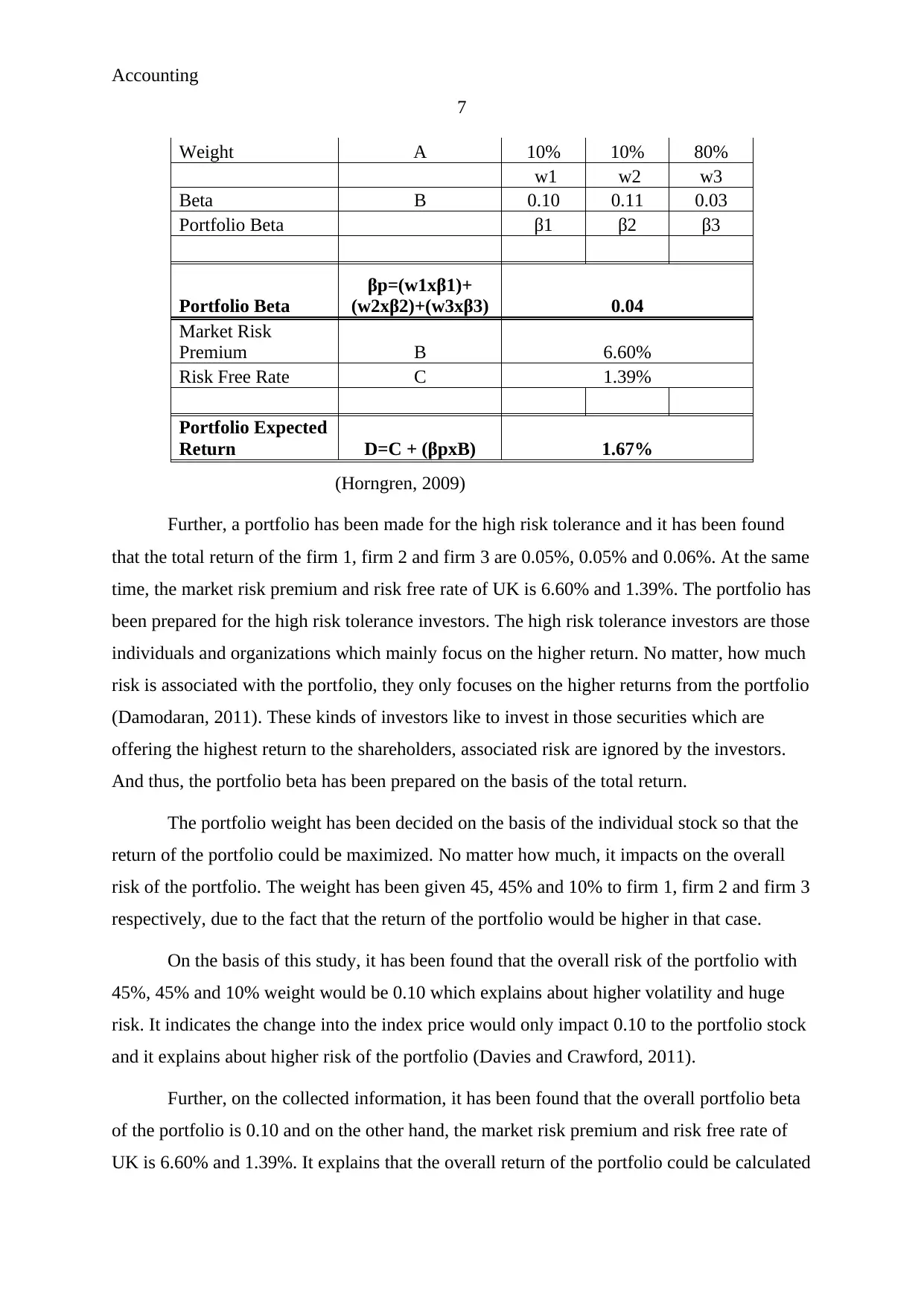
Accounting
7
Weight A 10% 10% 80%
w1 w2 w3
Beta B 0.10 0.11 0.03
Portfolio Beta β1 β2 β3
Portfolio Beta
βp=(w1xβ1)+
(w2xβ2)+(w3xβ3) 0.04
Market Risk
Premium B 6.60%
Risk Free Rate C 1.39%
Portfolio Expected
Return D=C + (βpxB) 1.67%
(Horngren, 2009)
Further, a portfolio has been made for the high risk tolerance and it has been found
that the total return of the firm 1, firm 2 and firm 3 are 0.05%, 0.05% and 0.06%. At the same
time, the market risk premium and risk free rate of UK is 6.60% and 1.39%. The portfolio has
been prepared for the high risk tolerance investors. The high risk tolerance investors are those
individuals and organizations which mainly focus on the higher return. No matter, how much
risk is associated with the portfolio, they only focuses on the higher returns from the portfolio
(Damodaran, 2011). These kinds of investors like to invest in those securities which are
offering the highest return to the shareholders, associated risk are ignored by the investors.
And thus, the portfolio beta has been prepared on the basis of the total return.
The portfolio weight has been decided on the basis of the individual stock so that the
return of the portfolio could be maximized. No matter how much, it impacts on the overall
risk of the portfolio. The weight has been given 45, 45% and 10% to firm 1, firm 2 and firm 3
respectively, due to the fact that the return of the portfolio would be higher in that case.
On the basis of this study, it has been found that the overall risk of the portfolio with
45%, 45% and 10% weight would be 0.10 which explains about higher volatility and huge
risk. It indicates the change into the index price would only impact 0.10 to the portfolio stock
and it explains about higher risk of the portfolio (Davies and Crawford, 2011).
Further, on the collected information, it has been found that the overall portfolio beta
of the portfolio is 0.10 and on the other hand, the market risk premium and risk free rate of
UK is 6.60% and 1.39%. It explains that the overall return of the portfolio could be calculated
7
Weight A 10% 10% 80%
w1 w2 w3
Beta B 0.10 0.11 0.03
Portfolio Beta β1 β2 β3
Portfolio Beta
βp=(w1xβ1)+
(w2xβ2)+(w3xβ3) 0.04
Market Risk
Premium B 6.60%
Risk Free Rate C 1.39%
Portfolio Expected
Return D=C + (βpxB) 1.67%
(Horngren, 2009)
Further, a portfolio has been made for the high risk tolerance and it has been found
that the total return of the firm 1, firm 2 and firm 3 are 0.05%, 0.05% and 0.06%. At the same
time, the market risk premium and risk free rate of UK is 6.60% and 1.39%. The portfolio has
been prepared for the high risk tolerance investors. The high risk tolerance investors are those
individuals and organizations which mainly focus on the higher return. No matter, how much
risk is associated with the portfolio, they only focuses on the higher returns from the portfolio
(Damodaran, 2011). These kinds of investors like to invest in those securities which are
offering the highest return to the shareholders, associated risk are ignored by the investors.
And thus, the portfolio beta has been prepared on the basis of the total return.
The portfolio weight has been decided on the basis of the individual stock so that the
return of the portfolio could be maximized. No matter how much, it impacts on the overall
risk of the portfolio. The weight has been given 45, 45% and 10% to firm 1, firm 2 and firm 3
respectively, due to the fact that the return of the portfolio would be higher in that case.
On the basis of this study, it has been found that the overall risk of the portfolio with
45%, 45% and 10% weight would be 0.10 which explains about higher volatility and huge
risk. It indicates the change into the index price would only impact 0.10 to the portfolio stock
and it explains about higher risk of the portfolio (Davies and Crawford, 2011).
Further, on the collected information, it has been found that the overall portfolio beta
of the portfolio is 0.10 and on the other hand, the market risk premium and risk free rate of
UK is 6.60% and 1.39%. It explains that the overall return of the portfolio could be calculated
Paraphrase This Document
Need a fresh take? Get an instant paraphrase of this document with our AI Paraphraser
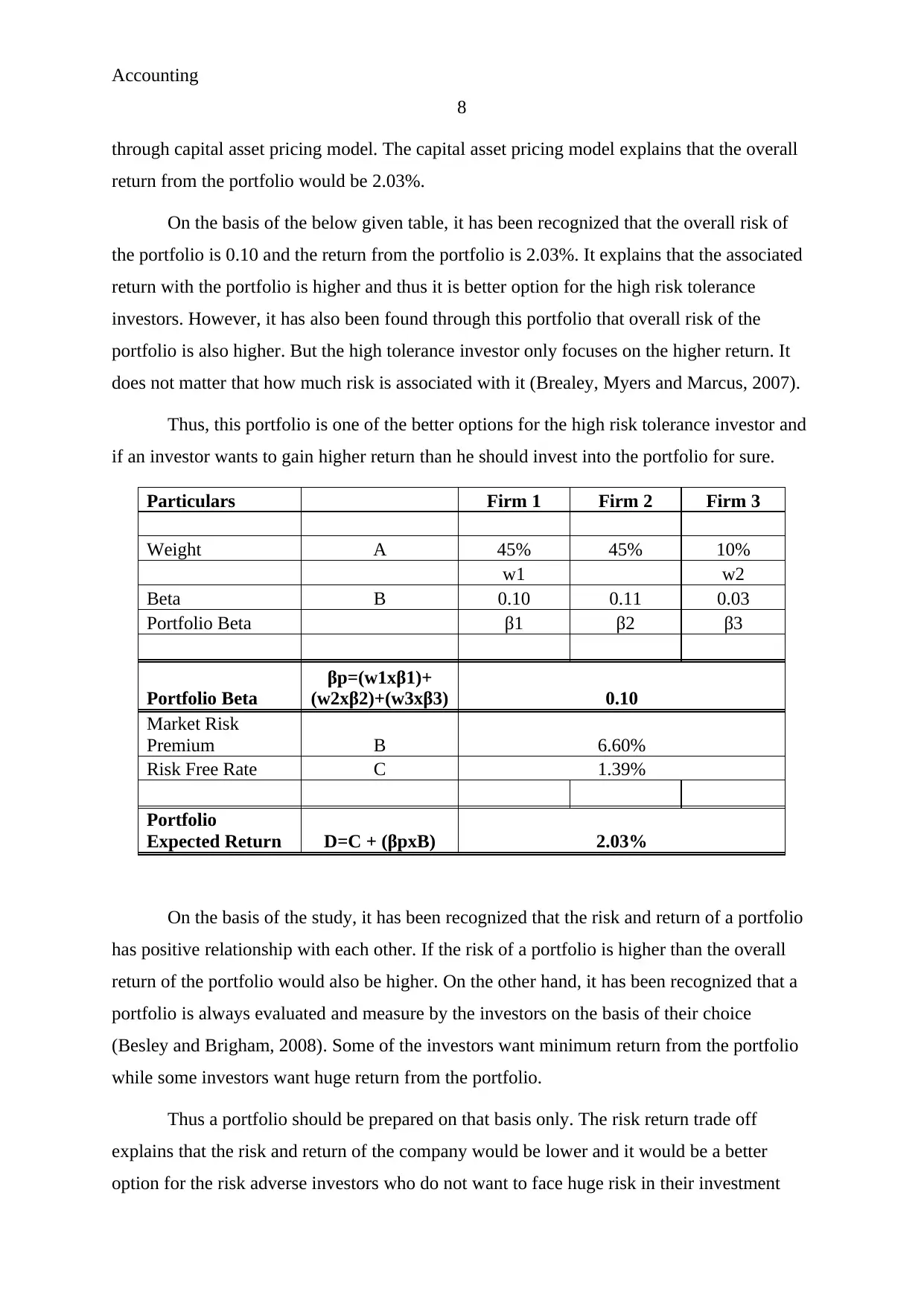
Accounting
8
through capital asset pricing model. The capital asset pricing model explains that the overall
return from the portfolio would be 2.03%.
On the basis of the below given table, it has been recognized that the overall risk of
the portfolio is 0.10 and the return from the portfolio is 2.03%. It explains that the associated
return with the portfolio is higher and thus it is better option for the high risk tolerance
investors. However, it has also been found through this portfolio that overall risk of the
portfolio is also higher. But the high tolerance investor only focuses on the higher return. It
does not matter that how much risk is associated with it (Brealey, Myers and Marcus, 2007).
Thus, this portfolio is one of the better options for the high risk tolerance investor and
if an investor wants to gain higher return than he should invest into the portfolio for sure.
Particulars Firm 1 Firm 2 Firm 3
Weight A 45% 45% 10%
w1 w2
Beta B 0.10 0.11 0.03
Portfolio Beta β1 β2 β3
Portfolio Beta
βp=(w1xβ1)+
(w2xβ2)+(w3xβ3) 0.10
Market Risk
Premium B 6.60%
Risk Free Rate C 1.39%
Portfolio
Expected Return D=C + (βpxB) 2.03%
On the basis of the study, it has been recognized that the risk and return of a portfolio
has positive relationship with each other. If the risk of a portfolio is higher than the overall
return of the portfolio would also be higher. On the other hand, it has been recognized that a
portfolio is always evaluated and measure by the investors on the basis of their choice
(Besley and Brigham, 2008). Some of the investors want minimum return from the portfolio
while some investors want huge return from the portfolio.
Thus a portfolio should be prepared on that basis only. The risk return trade off
explains that the risk and return of the company would be lower and it would be a better
option for the risk adverse investors who do not want to face huge risk in their investment
8
through capital asset pricing model. The capital asset pricing model explains that the overall
return from the portfolio would be 2.03%.
On the basis of the below given table, it has been recognized that the overall risk of
the portfolio is 0.10 and the return from the portfolio is 2.03%. It explains that the associated
return with the portfolio is higher and thus it is better option for the high risk tolerance
investors. However, it has also been found through this portfolio that overall risk of the
portfolio is also higher. But the high tolerance investor only focuses on the higher return. It
does not matter that how much risk is associated with it (Brealey, Myers and Marcus, 2007).
Thus, this portfolio is one of the better options for the high risk tolerance investor and
if an investor wants to gain higher return than he should invest into the portfolio for sure.
Particulars Firm 1 Firm 2 Firm 3
Weight A 45% 45% 10%
w1 w2
Beta B 0.10 0.11 0.03
Portfolio Beta β1 β2 β3
Portfolio Beta
βp=(w1xβ1)+
(w2xβ2)+(w3xβ3) 0.10
Market Risk
Premium B 6.60%
Risk Free Rate C 1.39%
Portfolio
Expected Return D=C + (βpxB) 2.03%
On the basis of the study, it has been recognized that the risk and return of a portfolio
has positive relationship with each other. If the risk of a portfolio is higher than the overall
return of the portfolio would also be higher. On the other hand, it has been recognized that a
portfolio is always evaluated and measure by the investors on the basis of their choice
(Besley and Brigham, 2008). Some of the investors want minimum return from the portfolio
while some investors want huge return from the portfolio.
Thus a portfolio should be prepared on that basis only. The risk return trade off
explains that the risk and return of the company would be lower and it would be a better
option for the risk adverse investors who do not want to face huge risk in their investment
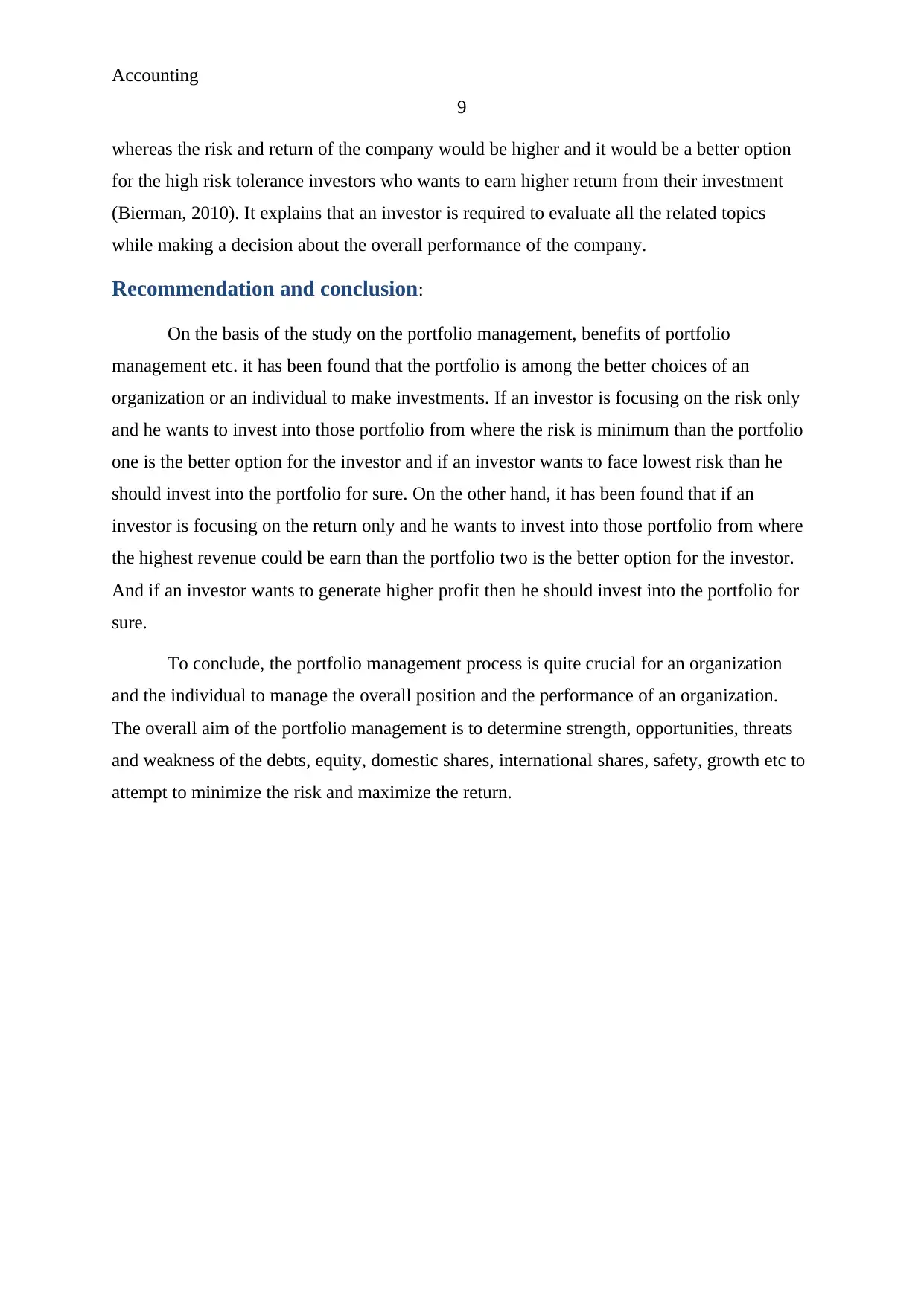
Accounting
9
whereas the risk and return of the company would be higher and it would be a better option
for the high risk tolerance investors who wants to earn higher return from their investment
(Bierman, 2010). It explains that an investor is required to evaluate all the related topics
while making a decision about the overall performance of the company.
Recommendation and conclusion:
On the basis of the study on the portfolio management, benefits of portfolio
management etc. it has been found that the portfolio is among the better choices of an
organization or an individual to make investments. If an investor is focusing on the risk only
and he wants to invest into those portfolio from where the risk is minimum than the portfolio
one is the better option for the investor and if an investor wants to face lowest risk than he
should invest into the portfolio for sure. On the other hand, it has been found that if an
investor is focusing on the return only and he wants to invest into those portfolio from where
the highest revenue could be earn than the portfolio two is the better option for the investor.
And if an investor wants to generate higher profit then he should invest into the portfolio for
sure.
To conclude, the portfolio management process is quite crucial for an organization
and the individual to manage the overall position and the performance of an organization.
The overall aim of the portfolio management is to determine strength, opportunities, threats
and weakness of the debts, equity, domestic shares, international shares, safety, growth etc to
attempt to minimize the risk and maximize the return.
9
whereas the risk and return of the company would be higher and it would be a better option
for the high risk tolerance investors who wants to earn higher return from their investment
(Bierman, 2010). It explains that an investor is required to evaluate all the related topics
while making a decision about the overall performance of the company.
Recommendation and conclusion:
On the basis of the study on the portfolio management, benefits of portfolio
management etc. it has been found that the portfolio is among the better choices of an
organization or an individual to make investments. If an investor is focusing on the risk only
and he wants to invest into those portfolio from where the risk is minimum than the portfolio
one is the better option for the investor and if an investor wants to face lowest risk than he
should invest into the portfolio for sure. On the other hand, it has been found that if an
investor is focusing on the return only and he wants to invest into those portfolio from where
the highest revenue could be earn than the portfolio two is the better option for the investor.
And if an investor wants to generate higher profit then he should invest into the portfolio for
sure.
To conclude, the portfolio management process is quite crucial for an organization
and the individual to manage the overall position and the performance of an organization.
The overall aim of the portfolio management is to determine strength, opportunities, threats
and weakness of the debts, equity, domestic shares, international shares, safety, growth etc to
attempt to minimize the risk and maximize the return.

Accounting
10
References:
Besley, S. and Brigham, E.F., 2008. Essentials of managerial finance. Thomson South-
Western.
Bierman, H., 2010. An introduction to accounting and managerial finance: a merger of
equals. World Scientific.
Bloomberg. 2018. Rates and bonds. (online). Available at:
https://www.bloomberg.com/markets/rates-bonds/government-bonds/uk (accessed 11/6/18).
Borio, C., 2014. The financial cycle and macroeconomics: What have we learnt?. Journal of
Banking & Finance, 45, pp.182-198.
Brealey, R., Myers, S.C. and Marcus, A.J., 2007. FundamentalsofCorporate Finance. Mc
Graw Hill, New York.
Bromwich, M. and Bhimani, A., 2005. Management accounting: Pathways to progress. Cima
publishing.
Damodaran, A, 2011, Applied corporate finance,3rd edition, John Wiley & sons, USA.
Davies, T. and Crawford, I., 2011. Business accounting and finance. Pearson.
Horngren, C.T., 2009. Cost accounting: A managerial emphasis, 13/e. Pearson Education
India.
Market risk premia. 2018. Market return. (online). Available at http://www.market-risk-
premia.com/gb.html (accessed 11/6/18).
Moles, P. Parrino, R & Kidwekk, D,.2011, Corporate finance, European edition, John Wiley
&sons, United Kingdom
Needles, B., Powers, M. and Crosson, S., 2013. Financial and managerial accounting. Nelson
Education.
Niu, F.F., 2006. Corporate governance and the quality of accounting earnings: a Canadian
perspective. International Journal of Managerial Finance, 2(4), pp.302-327.
Nobes, C. and Parker, R.H., 2008. Comparative international accounting. Pearson Education.
10
References:
Besley, S. and Brigham, E.F., 2008. Essentials of managerial finance. Thomson South-
Western.
Bierman, H., 2010. An introduction to accounting and managerial finance: a merger of
equals. World Scientific.
Bloomberg. 2018. Rates and bonds. (online). Available at:
https://www.bloomberg.com/markets/rates-bonds/government-bonds/uk (accessed 11/6/18).
Borio, C., 2014. The financial cycle and macroeconomics: What have we learnt?. Journal of
Banking & Finance, 45, pp.182-198.
Brealey, R., Myers, S.C. and Marcus, A.J., 2007. FundamentalsofCorporate Finance. Mc
Graw Hill, New York.
Bromwich, M. and Bhimani, A., 2005. Management accounting: Pathways to progress. Cima
publishing.
Damodaran, A, 2011, Applied corporate finance,3rd edition, John Wiley & sons, USA.
Davies, T. and Crawford, I., 2011. Business accounting and finance. Pearson.
Horngren, C.T., 2009. Cost accounting: A managerial emphasis, 13/e. Pearson Education
India.
Market risk premia. 2018. Market return. (online). Available at http://www.market-risk-
premia.com/gb.html (accessed 11/6/18).
Moles, P. Parrino, R & Kidwekk, D,.2011, Corporate finance, European edition, John Wiley
&sons, United Kingdom
Needles, B., Powers, M. and Crosson, S., 2013. Financial and managerial accounting. Nelson
Education.
Niu, F.F., 2006. Corporate governance and the quality of accounting earnings: a Canadian
perspective. International Journal of Managerial Finance, 2(4), pp.302-327.
Nobes, C. and Parker, R.H., 2008. Comparative international accounting. Pearson Education.
Secure Best Marks with AI Grader
Need help grading? Try our AI Grader for instant feedback on your assignments.
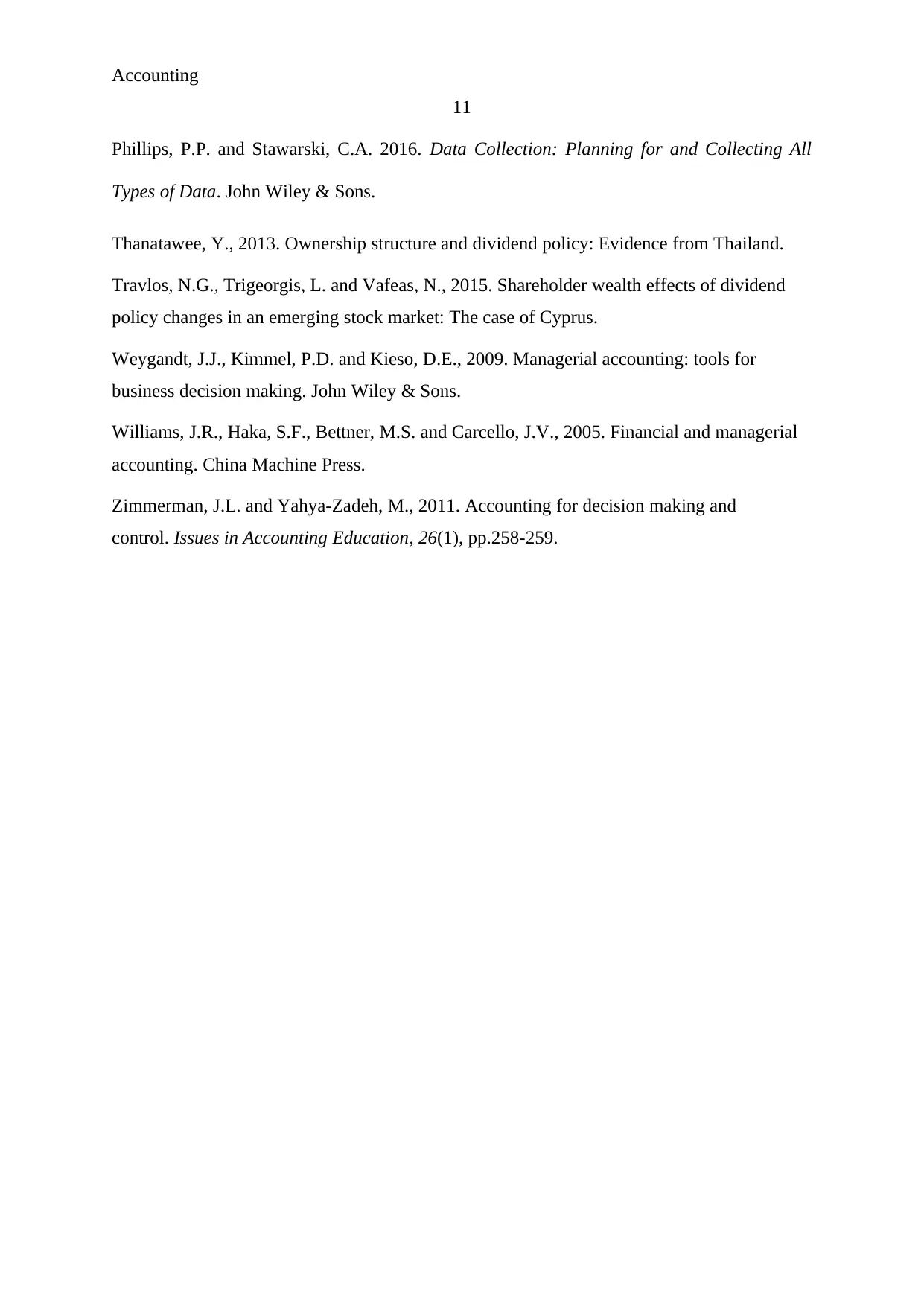
Accounting
11
Phillips, P.P. and Stawarski, C.A. 2016. Data Collection: Planning for and Collecting All
Types of Data. John Wiley & Sons.
Thanatawee, Y., 2013. Ownership structure and dividend policy: Evidence from Thailand.
Travlos, N.G., Trigeorgis, L. and Vafeas, N., 2015. Shareholder wealth effects of dividend
policy changes in an emerging stock market: The case of Cyprus.
Weygandt, J.J., Kimmel, P.D. and Kieso, D.E., 2009. Managerial accounting: tools for
business decision making. John Wiley & Sons.
Williams, J.R., Haka, S.F., Bettner, M.S. and Carcello, J.V., 2005. Financial and managerial
accounting. China Machine Press.
Zimmerman, J.L. and Yahya-Zadeh, M., 2011. Accounting for decision making and
control. Issues in Accounting Education, 26(1), pp.258-259.
11
Phillips, P.P. and Stawarski, C.A. 2016. Data Collection: Planning for and Collecting All
Types of Data. John Wiley & Sons.
Thanatawee, Y., 2013. Ownership structure and dividend policy: Evidence from Thailand.
Travlos, N.G., Trigeorgis, L. and Vafeas, N., 2015. Shareholder wealth effects of dividend
policy changes in an emerging stock market: The case of Cyprus.
Weygandt, J.J., Kimmel, P.D. and Kieso, D.E., 2009. Managerial accounting: tools for
business decision making. John Wiley & Sons.
Williams, J.R., Haka, S.F., Bettner, M.S. and Carcello, J.V., 2005. Financial and managerial
accounting. China Machine Press.
Zimmerman, J.L. and Yahya-Zadeh, M., 2011. Accounting for decision making and
control. Issues in Accounting Education, 26(1), pp.258-259.
1 out of 11
Related Documents
Your All-in-One AI-Powered Toolkit for Academic Success.
+13062052269
info@desklib.com
Available 24*7 on WhatsApp / Email
![[object Object]](/_next/static/media/star-bottom.7253800d.svg)
Unlock your academic potential
© 2024 | Zucol Services PVT LTD | All rights reserved.





